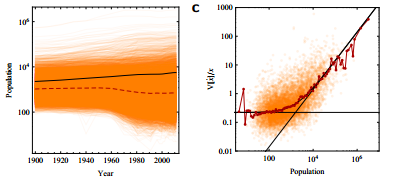Demographers Discover The Fundamental Law Governing the Growth of Cities
When you live in a city, you can sense its pulse, experience its pace of life and get to know its unique character. It’s almost as if a city is a living, breathing entity in its own right.

That may be little more than the fantastical imaginings of city dwellers who tend to humanise all things inanimate. And yet, there is much demographic evidence to show that cities have their own unique identity, even though they are made up of millions of seemingly independent individuals.
One test of the idea that cities are coherent entities is the ability to predict their future characteristics based on their past behaviour. Today, Alberto Hernando at the École Polytechnique Fédérale de Lausanne in Switzerland and a couple of pals show that this is indeed the case.
Hernando and co asked whether a city’s population growth in the current year depends on its growth in previous years. To find the answer, they examined a database compiled by the Spanish government between 1900 and 2011 of the population of 8100 municipalities throughout the country.
Their results show that for cities with a population of more than 10,000, the future growth depends clearly on the past. However, this dependence on the past reaches a maximum after about 15 years and then declines. So city growth has a kind of inertia with a characteristic time scale of about 15 years or so
What’s more, Hernando and co say that a city’s growth also depends on the growth of cities nearby. So cities somehow influence each other. Hernando and co say this effect is most pronounced over distances up to 80 kilometres and then drops of as 1/r^2.
These results are significant because they show that city behaviour is predictable over certain timescales, even though growth is the result of the seemingly independent decisions made by millions of different people. Nevertheless, these independent behaviours can be described by a single law that governs city growth and can be used iot predict how urban populations will change in future.
That’s the kind of phenomenon that city planners ought to find extremely useful. But it will be important to work how cultural and socio-economic factors influence these growth patterns. Hernando and co say that while the growth patterns they have discovered hold true at a coarse scale, they can see other less strong correlations that also influence growth rates. “We expect that these correlations will depend on local circumstances and also on the particular socio-economic status of each city,” they say.
It’s not hard to imagine how local factors may come to dominate growth rates. For example, the pattern of city growth in a country with an ancient history such as Spain might be rather different to growth patterns in a younger country like the United States.
Identifying these local factors will be important but may also be difficult to characterise.
Nevertheless, the notion that city growth is predictable at all will be a useful new tool for urban planners who want to better understand these living, breathing entities in which we live. It may also help to ease the stresses and strains that cities experience when influxes and exoduses occur.
Ref: arxiv.org/abs/1306.3656: Space-Time Correlations In Urban Sprawl
Keep Reading
Most Popular
Large language models can do jaw-dropping things. But nobody knows exactly why.
And that's a problem. Figuring it out is one of the biggest scientific puzzles of our time and a crucial step towards controlling more powerful future models.
How scientists traced a mysterious covid case back to six toilets
When wastewater surveillance turns into a hunt for a single infected individual, the ethics get tricky.
The problem with plug-in hybrids? Their drivers.
Plug-in hybrids are often sold as a transition to EVs, but new data from Europe shows we’re still underestimating the emissions they produce.
Stay connected
Get the latest updates from
MIT Technology Review
Discover special offers, top stories, upcoming events, and more.